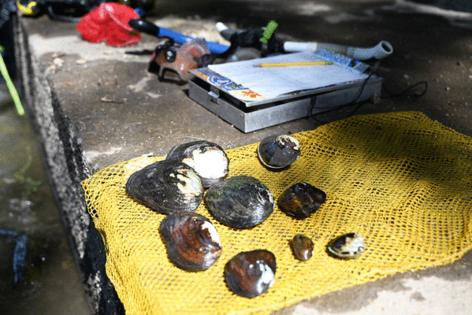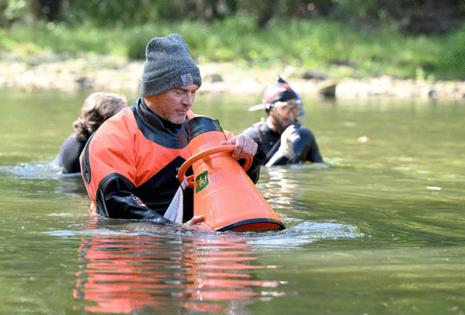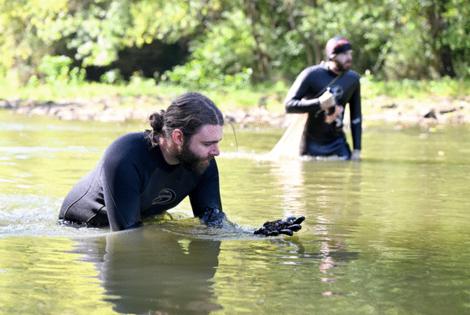Why the discovery of a golf-ball-sized 'hickorynut' mussel in the Shenango River is a big deal
Published in Outdoors
PITTSBURGH — They dove and snorkeled in the Mercer County portion of the Shenango River the second week of September to locate Pennsylvania's rarest endangered freshwater mussel: the round hickorynut.
They found two specimens — one live, one dead — of the plain-looking mussel species, which is round and the size of a golf ball.
"The fact we only found one hickory nut alive, after looking for five days, is really important," said Eric Chapman, director of aquatic science for the Western Pennsylvania Conservancy. Discovered Sept. 9, the first of several days of dives, it was the first time that the researcher saw a live specimen in the wild in more than 20 years of underwater surveys.
The discovery of the rare round hickorynut underscores the critical status of this mussel and will drive more intensive research next year to better assess its population in the Shenango for future conservation efforts.
"There is not another place in the state where this species occurs other than this stretch of the Shenango River," said Nevin Welte, malacologist and nongame biologist for the Pennsylvania Fish and Boat Commission.
The Conservancy and the commission, with some help from the state Department of Environmental Protection, surveyed a 9-mile stretch from Kidds Mill Bridge to the Big Bend Recreation Area near Greenville in Mercer County.
The nearly 100-mile Shenango River, which starts near Lake Pymatuning, runs through Crawford, Mercer and Lawrence counties before it meets the Mahoning River, forming the Beaver River. The river also runs through a small portion of northeastern Ohio.
Similar to a Midwestern river, the Shenango is unusually windy and meandering, with a lot of wood, or downed trees, and oxbows, Welte said.
This unique river, which is home to numerous bald eagles, also hosts multiple rare and endangered mussel species.
The round hickorynut is not as flashy as the state-endangered pistolgrip and federally-endangered snuffbox mussels that the researchers also turned up.
All three species come in shapes resembling objects that were commonplace a few centuries ago when they were first discovered and named.
The hickorynut is battling habitat degradation and loss, genetic isolation and invasive and non-native species, according to the U.S. Fish & Wildlife Service.
Native bivalves are treasured by biologists because a single mussel can filter between eight and 15 gallons of water a day, including harmful algae and pollutants. In large enough numbers, these "livers of the river" can dramatically boost water quality for all wildlife and drinking water.
Although mussels are found in many waterways in Western Pennsylvania, the three most important sites — in terms of numbers and species variety — are French Creek, the Allegheny River and the Shenango, said Chapman.
Pennsylvania's Wild Resource Conservation program, which offers the wildlife state license plates, was a major funder for the survey.
Some mussel species can live up to 100 years. During this month's dive, the researchers found another encouraging sign: mussels of varying ages.
"Everyone gets excited when they find big mussels," Chapman said. "I like the small ones because then you know reproduction is happening.
"It's expensive to reproduce. The stars have to align with mussels, which have to find a fish to complete their life history."
To survive, infant mussels attach to fish for oxygen, nutrients and safety, then eventually drop off in new river areas.
Researchers found 17 mussel species in the September dives, following up on extensive surveys by the U.S. Geological Survey in 2009 and 2010.
They winnowed down the most promising sections of the Shenango to later hit the most productive and promising sections lined with beds of gravel and sand, which mussels love.
"Mussel vision" is a must for researchers scouring the river bottoms.
In a sea of river rock, and with myriad sizes and shapes, Alysha Trexler, watershed program manager for the Western Pennsylvania Conservancy, can easily pick out the mussels.
Trexler and her colleagues hone their identification skills after years of diving to survey mussels and other aquatic life.
"It's feeling and looking, moving soil and looking for glints of white from a mussel shell," she said.
It was tough going in some parts of the Shenango, with a river bottom that was covered in silt, which limited visibility to only 6 inches underwater.
In those moments, Trexler dug her hands in the river bottom to feel her way around.
"Mussels feel smooth compared to a rock. They feel alive. They are lighter and have more texture."
And one doesn't "rip" a mussel from the river bottom: "You feel for its foot and encourage them to move," she said.
These freshwater clams have a single muscular foot used for moving around and inserting into the substrate, to stay anchored.
"Mussels are amazingly strong," Mary Walsh, invertebrate zoology manager of the Conservancy, said. "You gently pull them."
While most people will never pull a mussel from the river, the nonprofit Shenango River Watchers celebrate their presence and promote the mollusks as a sign of clean water.
The recently surveyed section hasn't been hampered by industrial runoff for at least 25 years, said Joan Christy, a board member with Shenango River Watchers, which restores, protects and promotes recreational use of the waterway.
"That section of the river has restored itself over time," Christy said. "We see a healthy population of mussels, and when we teach environmental education to school kids, we give examples of mussels living in the river."
The Kidds Mills section is one of the Shenango's most popular stretches, with a parking lot and canoe and kayak launch, she said.
Paddlers gravitate to the Shenango because large sections aren't developed. Much of the land along the river is owned by the U.S. Army Corps of Engineers, which operates the Shenango dam and reservoir.
The River Watchers maintains a 23-mile water trail, six kayak launches, and the 9-mile Shenango trail, along the river.
The group spends more than $2,000 annually clearing parts of downed trees to prevent blockages, especially following storms and high water, Christy said.
The group hosts a spring and fall Paddle Fest for the public that attracts between 200-250 paddlers.
In 2021, the public voted in a contest hosted by the state Department of Conservation and Natural Resources to name the Shenango as River of the Year.
____
© 2025 the Pittsburgh Post-Gazette. Visit www.post-gazette.com. Distributed by Tribune Content Agency, LLC.












Comments